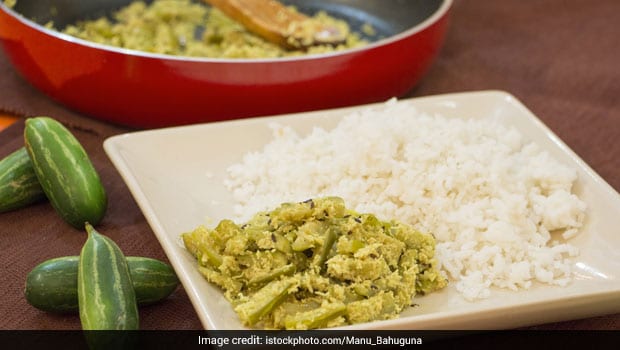However, food researcher Pritha Sen likes to differ, and doubts the possibility of the Portuguese connection in the emergence of the dish. Elaborating on how the custom of eating bitter dates back to the ancient Ayurvedic dietary practices, she says, "The Portuguese arrived in Bengal in the 16th century and the medicinal value of eating bitters at the start of a meal was laid down from ancient times by the great sages and physicians of Ayurveda, Charaka, Susruta, Dhanwantari et al. Bengal is probably the last bastion of the ayurvedic way of eating. The shukto was a cooling agent in the hot, humid climates of Anga, Vanga and Kalinga, what I would like to refer to as the Undivided Bengal. It was also said that it excited the digestive juices before the start of the actual meal. It finds mention in the Mangalkavyas, a corpus of narrative poetry composed in Bengal in the medieval age, it finds mention in the life and food habits of Sri Chaitanya of the Bhakti movement, times before the Portuguese.
She goes on to add, "It finds mention in meals requested by the gods of their spouses! For example, in one of the Mangalkavyas, Lord Shiva requests Goddess Annapurna, the deity of plenty, to cook shukto for him. Many of the women protagonists of the Mangalkavyas cook elaborate meals including the shukto. Therefore I find it hard to believe that a 'Firinghee' (as the Portuguese were referred to) dish could find such acceptance in a short span of time, when the tomato is still struggling to find a definitive place in Bengali cuisine. It is more likely that the Portuguese, who inter-married, made it their own in their own way."
'Dudh Shukto' is a very popular dish prepared in most Bengali homes, with milk added to the bitter dish to help alleviate the taste and make it more palatable. Bengali cuisine is renowned for its rich range of subtle and fiery flavours. It is also famous for its traditionally developed multi-course tradition, unlike in many other parts of the country. In a Bengali thali, food is served course-wise rather than all at once and Shukto kick starts a quintessential Bengali lunch with its bitter tinge. The feast then finally concludes with a round of sweets or desserts. Renowned food historian KT Acharya writes in his book 'A Historical Dictionary of Indian Food' about Shukto and the multi-course Bengali meal which is kick started by Shukto , "In Bengal, a bitter item Shukto is included at the start of the afternoon meal. Sweets are served at the very end... A terminal digestive paan is to follow."

Shukto makes for a delightful accompaniment to rice, dal and fish
About the traditional preparation of Shukto, Pritha Sen says, "Shukto is more of a method of cooking than a dish, she says “Shukto is not really the name of one single dish. It is essentially a style and method of cooking a starter which is the jewel in the crown of Bengali cuisine. A slow stewing, the flavours standing on just tempering with minimal oil or ghee and finished off with a dominant ginger paste addition. It is made with a combination of summer vegetables, most with preventive and curative properties. Bitter is the protagonist in this dish but never overpowering. While the Portuguese dish stands just on bitter gourd, the Shukto in Bengal was and where available, still is made with a plethora of bitter greens like neem leaves, parwal leaves, jute leaves, karela leaves, cucumber leaves, shefali or night jasmine leaves, moringa leaves, helenchasaag etc. Among the vegetables used are/were green banana, raw papaya, ridge gourd, brinjal, teasel gourd, pointed gourd , bamboo shoots, banana stem, sweet potato.”
She adds, “Shuktos are also made from only green leafy vegetables like red amaranth (red cholai saag), fresh shoots of jute etc. There are many Shuktos made with fish as well, ranging from big to small. These have haldi as opposed to the vegetarian ones and sometimes without bitter greens or vegetables, the bitterness introduced with the use of powdered roasted fenugreek seeds.”
You can make the delicacy at your home with this delicious recipe by Chef Andy and Rajan- Shukto.
About Sushmita SenguptaSharing a strong penchant for food, Sushmita loves all things good, cheesy and greasy. Her other favourite pastime activities other than discussing food includes, reading, watching movies and binge-watching TV shows.












